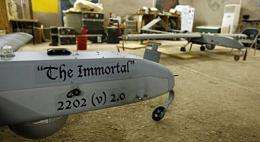Pentagon plays down security breach with US drones

A day after the Pentagon acknowledged that Iraqi militants had used cheap software to intercept US drone feeds, a new report on Friday said senior military officials had dismissed that risk in 2004.
On Thursday, military officials sought to play down security concerns after the Wall Street Journal revealed that militants in Iraq and Afghanistan had intercepted the unencrypted downlink between US drones and ground control.
"This is an old issue that's been addressed," a defense official, speaking on condition of anonymity, told reporters.
The problem had been taken care of, he said, without elaborating.
But on Friday, the Journal reported that the Pentagon began addressing the issue only this year, despite fears going back to 2004 that Russia or China might intercept and doctor video feeds from the unmanned US aircraft.
The Journal said Friday that members of the Joint Chiefs of Staff discussed the vulnerability posed by the lack of encryption in 2004 and 2005.
Citing two officers with knowledge of the talks, the newspaper said concerns focused on the possibility of interference by national militaries and officials assumed insurgents would not be able to exploit the flaw.
"The main concern was that the video feeds were being intercepted, manipulated and then fed to the commanders in the field," an officer told the paper.
But senior members of the Joint Staff dismissed those concerns.
The military did not begin addressing the flaw until video footage from a drone feed was discovered on the laptop of a captured Shiite Iraqi militant earlier this year.
Officials on Thursday confirmed Iranian-backed Shiite insurgents in Iraq had used software programs such as SkyGrabber -- available online for 25.95 dollars (18 euros) -- to capture the live video footage from the drones.
Some sensitive video feeds from drones are routinely encrypted, another defense official, who asked not to be named, told AFP on Thursday. But the extent of the encryption remained unclear.
Even as officials insisted the problem had been rectified, a military technology blog reported the vulnerability extended to video transmissions for an array of other US aircraft -- both manned and unmanned.
The reports exposed a possible weak link in the US military's growing use of unmanned vehicles and live video feeds, crucial for combat operations in Afghanistan and Iraq and CIA manhunts against Al-Qaeda figures in Pakistan.
The Pentagon is deploying more armed and unarmed drones to Afghanistan to back up a surge of US forces there, and has placed a high priority on expanding and improving the fleet of unmanned aircraft.
The Defense Department said in a statement that it "constantly evaluates and seeks to improve the performance and security of our various" drone systems.
"As we identify shortfalls, we correct them as part of a continuous process of seeking to improve capabilities and security.
"As a matter of policy, we don't comment on specific vulnerabilities or intelligence issues," it said.
There was no evidence that militants could control the drones or otherwise interfere with their flights, but the vulnerability would allow the unmanned craft to be monitored and tracked.
The first evidence that militants had exploited the weakness came in July 2009, with the discovery of drone feed footage on a captured laptop in Iraq.
They discovered "days and days and hours and hours of proof," an unnamed source told the Journal. "It is part of their kits now."
The military has reportedly discovered evidence of similar interceptions in Afghanistan and the same technique could be used in other places where the US forces operate the drones, including Yemen and Somalia, the Journal said.
Questions over intercepted feeds came a day after Lieutenant General David Deptula, Air Force deputy chief of staff for intelligence, surveillance and reconnaissance, told reporters that some unmanned aircraft in Afghanistan soon would be equipped with a new hi-tech camera system called "Gorgon Stare" -- allowing a drone to beam back at least 10 separate video feeds at the same time.
Earlier Thursday, two separate missile strikes by US drones killed at least 14 militants in northwest Pakistan, security officials there said.
(c) 2009 AFP



















